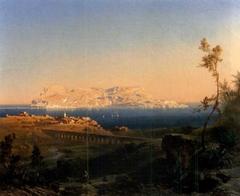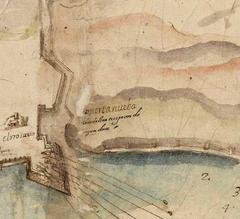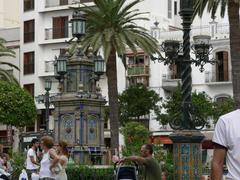Comprehensive Guide to Visiting Punta del Carnero, Algeciras, Spain
Date: 01/08/2024
Introduction
Punta del Carnero, situated near Algeciras, Spain, stands as a remarkable destination that intertwines rich historical significance with natural splendor. This headland, overlooking the Strait of Gibraltar, is not only a site of strategic military importance but also a haven for nature enthusiasts and history aficionados. The Punta Carnero Lighthouse, constructed in 1874 by Jaime Font, is a testament to the area’s maritime heritage and has guided countless vessels through the vital passage connecting the Mediterranean Sea to the Atlantic Ocean (wikimili.com). Furthermore, the region has witnessed pivotal events, such as medieval conflicts during the Reconquest of Spain, and has been fortified to protect against invasions, leaving behind a tapestry of historical landmarks (wikipedia.org). The site’s cultural impact is also profound, with connections to legendary flamenco guitarist Paco de Lucía, who drew inspiration from the region for his famous composition “Entre dos aguas” (Andalucia.org). This comprehensive guide aims to provide visitors with detailed insights into Punta del Carnero’s historical background, visiting hours, travel tips, and key attractions, ensuring an enriching and memorable experience.
Table of Contents
- Introduction
- Historical Background
- Natural and Cultural Heritage
- Visitor Information
- Local Attractions
- Activities
- Dining
- Practical Tips
- Transportation
- Environmental Considerations
- FAQ
- Conclusion
Exploring Punta Carnero: Historical Significance, Visiting Hours, and Travel Tips
Historical Background
Early History and Strategic Importance
Punta Carnero has a rich historical tapestry woven with strategic military significance and maritime heritage. The area is notably marked by the Punta Carnero Lighthouse, which has been a crucial navigational aid since its construction in 1874. Designed by Jaime Font, the lighthouse overlooks the Strait of Gibraltar, a vital maritime passage connecting the Mediterranean Sea to the Atlantic Ocean (wikimili.com).
Medieval Conflicts and Reconquest
The region’s historical significance is further underscored by its involvement in medieval conflicts. In 1369, during the Reconquest of Spain, Muhammad V, the Emir of Granada, launched a siege to reclaim Algeciras from the Kingdom of Castile. The siege lasted only three days, resulting in a swift victory for the Emir. This victory was short-lived, however, as the city was completely destroyed in 1379 to prevent it from falling back into Christian hands (wikimili.com).
The Fortifications of Punta Carnero
The Fuerte de Punta Carnero, a fort built before 1735, played a pivotal role in the coastal defense system established after the loss of Gibraltar in 1704. This fort was part of a series of fortifications designed to protect shipping lanes and deter invasions from the British-held Rock of Gibraltar. The fort was strategically located where the Bay of Gibraltar meets the rugged coast of the Strait of Gibraltar, making it an essential military outpost (wikipedia.org).
Architectural and Military Features
The fort’s design included a watchtower for signaling, positioned slightly higher on the 20-meter cliffs than the main battery. It housed twenty soldiers, an artillery officer, a sergeant, and a corporal. By 1735, the fort was equipped with four guns, which were later increased to six 24-pounders by 1796. This fortification was crucial in maintaining Spanish control over the region’s maritime activities (wikipedia.org).
Destruction and Legacy
In 1810, during the Peninsular War, the Spanish fortifications around Gibraltar, including the Fuerte de Punta Carnero, were destroyed to prevent their use by Napoleon’s forces. Portuguese sailors demolished the fortifications around the bay shortly before the arrival of French cavalry in nearby San Roque. The remains of the fort were later used to construct the Punta Carnero Lighthouse, which stands as the main structure on the promontory today. Only a few walls of the original fort remain, serving as a historical reminder of the area’s turbulent past (wikipedia.org).
The Portuguese Fleet and the Conquest of Ceuta
In August 1415, Punta Carnero was the anchorage point for a Portuguese fleet led by King John I of Portugal. The fleet held a Council of War here before embarking on the conquest of Ceuta, a significant military campaign that marked the beginning of Portuguese expansion into North Africa. This event highlights Punta Carnero’s strategic importance not only in Spanish history but also in the broader context of Mediterranean maritime conflicts (wikimili.com).
The Aqueduct of Algeciras
Another significant historical structure in the vicinity is the Aqueduct of Algeciras, built in the eighteenth century. Despite common misconceptions that it is of Arabic or Roman origin, this aqueduct is a testament to the engineering prowess of the period and serves as an important landmark in Algeciras (wikimili.com).
Natural and Cultural Heritage
Punta Carnero is not only rich in historical and military significance but also boasts a unique natural and cultural heritage. The nearby Cala Arenas beach, situated within the El Estrecho Natural Park, offers a pristine environment largely undisturbed by human activity. The beach, consisting of three small coves with rocky and stony shores, is framed by cliffs and the Isla de las Palomas lies offshore. This natural setting provides a stark contrast to the historical ruins, offering visitors a glimpse into the region’s diverse landscape (wikimili.com).
Visitor Information
Visiting Hours and Tickets
The Punta Carnero Lighthouse and the surrounding areas are accessible to the public. While the lighthouse itself is not open for tours, visitors can explore the exterior grounds and enjoy the stunning views of the Strait of Gibraltar. There is no admission fee to visit the lighthouse or the ruins of the Fuerte de Punta Carnero.
Travel Tips
- Best Time to Visit: The best time to visit Punta Carnero is during the spring and fall when the weather is pleasant and the area is less crowded.
- Getting There: Punta Carnero is easily accessible by car from Algeciras. There are also local buses that can take you close to the site, but a short walk may be required.
- Nearby Attractions: While in the area, consider visiting other historical sites such as the Algeciras Port and the Plaza Alta. The El Estrecho Natural Park is also a must-see for nature enthusiasts.
- Accessibility: The site has uneven terrain and may not be fully accessible for visitors with mobility issues. Comfortable walking shoes are recommended.
Special Events and Guided Tours
While there are no regular guided tours, special events and historical reenactments occasionally take place at Punta Carnero. Check local tourism websites or contact the Algeciras tourist office for up-to-date information on events and tours.
Photographic Spots
Punta Carnero offers numerous picturesque spots perfect for photography. Key locations include the lighthouse, the ruins of the fort, and the stunning coastline views. Early morning and late afternoon provide the best lighting conditions for capturing the beauty of the area.
Local Attractions
Faro de Punta Carnero
The Faro de Punta Carnero is a must-visit landmark. This cylindrical sandstone lighthouse, designed by Jaime Font and inaugurated in 1874, offers breathtaking views of the Strait of Gibraltar and the African coast. The lighthouse is part of the Ruta Paco de Lucía, a cultural route dedicated to the famous flamenco guitarist who hailed from Algeciras.
Beaches
Punta del Carnero is home to several beautiful beaches. Getares Beach is known for its crystal-clear waters and golden sands, making it perfect for sunbathing and swimming. For a more lively atmosphere, visit El Rinconcillo Beach, which is popular for water sports such as windsurfing and kitesurfing. Both beaches have amenities like beach bars and restaurants where you can enjoy fresh seafood dishes.
Activities
Hiking
Nature enthusiasts will find plenty of hiking opportunities around Punta del Carnero. The Río de la Miel trail leads to a spectacular waterfall, while the Picacho Route offers panoramic views of the surrounding landscape. The Cliffs Route is another popular trail that provides stunning sea views and the chance to explore the rugged coastline.
Day Trips
Punta del Carnero’s strategic location makes it an excellent base for day trips. Consider taking a ferry from the Port of Algeciras to explore the Moroccan city of Tetouan, known as the “white dove of Morocco.” Alternatively, you can visit the historic cities of Cádiz and Jerez de la Frontera, both rich in cultural heritage and famous for their sherry wine production.
Dining
Algeciras offers a variety of dining options to suit all tastes. For a taste of local cuisine, visit the Mercado de Abastos, a historic market where you can sample fresh produce, seafood, and traditional Andalusian dishes. Other recommended restaurants include Punta Carnero, which offers a beachfront dining experience with stunning ocean views.
Practical Tips
- Currency: The local currency is the Euro (€). Credit cards are widely accepted, but it’s advisable to carry some cash for small purchases.
- Language: Spanish is the official language. While English is spoken in tourist areas, learning a few basic Spanish phrases can enhance your experience.
- Safety: Punta del Carnero is generally safe for tourists. However, it’s always wise to take standard precautions, such as keeping an eye on your belongings and avoiding isolated areas at night.
- Health: Tap water is safe to drink, and healthcare facilities are of a high standard. It’s recommended to have travel insurance that covers medical expenses.
- Local Customs: Spaniards are known for their warm hospitality. It’s customary to greet people with a handshake or a kiss on both cheeks. Tipping is appreciated but not obligatory; a 5-10% tip is considered generous.
Transportation
While renting a car is the most convenient way to explore Punta del Carnero and its surroundings, public transportation options are also available. Buses and taxis are readily accessible in Algeciras, and the city is well-connected by road to other major destinations in Andalusia.
Environmental Considerations
Punta del Carnero is part of a delicate coastal ecosystem. Visitors are encouraged to respect the natural environment by not littering, staying on designated trails, and avoiding disturbing local wildlife. Many beaches have recycling bins, so make use of them to help keep the area clean.
Frequently Asked Questions (FAQ)
What are the visiting hours for Punta Carnero?
The exterior grounds of Punta Carnero Lighthouse are accessible to the public at all times. However, it is recommended to visit during daylight hours for safety and better visibility.
Do I need tickets to visit Punta Carnero?
There are no tickets required to visit Punta Carnero. The site is open to the public free of charge.
Is Punta Carnero suitable for families?
Yes, Punta Carnero is a family-friendly destination. The site offers educational opportunities about the region’s history and plenty of open space for children to explore.
Conclusion
Punta Carnero offers a unique and enriching experience for visitors, blending historical significance with vibrant cultural traditions. From the iconic lighthouse to the rich culinary scene and lively festivals, it stands as a testament to Andalusia’s diverse culture. Whether exploring historical sites, enjoying local cuisine, or experiencing flamenco, Punta Carnero provides a memorable journey into the heart of Spanish culture.
References
- Wikimili.com, n.d., Punta Carnero, Spain wikimili.com
- Wikipedia.org, n.d., Fuerte de Punta Carnero wikipedia.org
- Andalucia.org, n.d., Faro de Punta Carnero andalucia.org
- Mapcarta, n.d., Fuerte de San García and Parque del Centenario mapcarta.com
- Spain-holiday.com, n.d., Feria Real de Algeciras and Semana Santa spain-holiday.com




